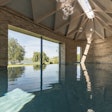Considering the size of public swimming pools and the price and scarcity of urban real estate available for development, finding suitable spaces for new public pools in big cities can be difficult, if not impossible. The city of New York, however, found a solution -?a floating pool. Dubbed "The Floating Pool Lady," the barge that has been retrofitted with a seven-lane, 82-foot-long pool surrounded by men's and women's locker rooms, showers and a children's spray pool, arrived in New York last October. The pool, docked near Brooklyn Bridge Park for now, will be ready for use as early as this summer and will permanently dock in an area previously deprived of a working swimming pool.
A self-contained facility that can be "plugged into" any waterfront site, the floating pool is the brainchild of Ann Buttenwieser, a former New York Parks Department official, whose goal was to draw people to the city's underused waterfront. She even started a nonprofit organization, the Neptune Foundation, to help the pool become a reality. To design the pool, Buttenwieser's foundation commissioned Jonathan Kirschenfeld, an architect who once designed a floating theater (which never got built, he says).
Together, Kirschenfeld and Buttenwieser scouted barges from Singapore to South America before settling on one, which in its former life was known as the New Orleans. Kirschenfeld said it cost $450,000.
"From the city's point of view, the floating pool concept is a very good one," said parks commissioner Adrian Benepe to The New York Times. "Building swimming pools is very, very expensive. And outdoor swimming pools, they have a short life in the summer, and you have to find lots of land for them, which can mean taking over park land that's used for something else. So a floating pool is an ideal solution."
The Floating Lady will not be the city's first such pool. Floating baths dotted the piers of New York City in the 19th and early 20th centuries. Those pools, however, were little more than enclosures filled with river water, and when health officials realized that raw sewage in the river got into the pools, the city retrofitted the pools with watertight tanks that held fresh water. The pools were a fixture of city life until World War I.











































